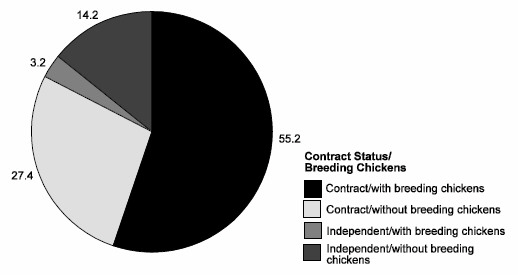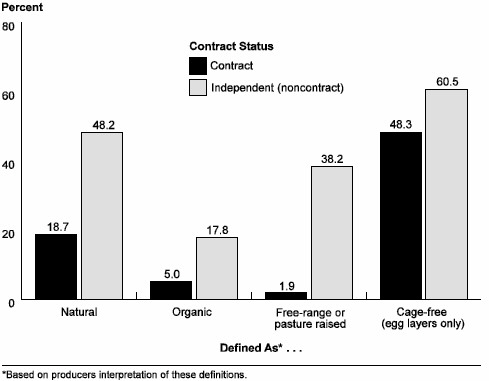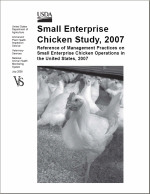



Management Practices on Small Enterprise Chicken Operations in the US
This report is a reference of management practices on small enterprise chicken operations in the United States in 2007. It is a co-operative effort between two US Department of Agriculture (USDA) agencies: the National Agricultural Statistics Service (NASS) and the Animal and Plant Health Inspection Service (APHIS).Introduction
The National Animal Health Monitoring System (NAHMS) is a non-regulatory program of the United States Department of Agriculture (USDA) designed to help meet the nation’s animal-health information needs.
Layers ’99 was NAHMS’ first national study on poultry baseline health and management. Layers ’99 estimated the prevalence and associated risk factors of Salmonella enterica Enteritidis in US layer flocks.
Poultry 2004 was NAHMS’ second study of the US poultry industry. It provided information about bird health, bird movement and biosecurity practices on backyard flocks, gamefowl breeder flocks and at live-poultry markets.
The Small Enterprise Chicken Study, 2007 is NAHMS’ third study of the poultry industry. The study provides national information on biosecurity practices and bird movement on operations with 1,000 to 19,999 chickens. The study was conducted in August 2007 and was based upon a statistically selected sample of 2,511 operations.
The methods used and the number of respondents in the study can be found here.


Conclusions
The NAHMS Small Enterprise Chicken Study 2007 provides insight into the types of operation comprise the small enterprise segment of the chicken industry, and provides information on the biosecurity and bird movement practices of these operations.
The study targeted operations in the United States with 1,000 to 19,999 chickens, based on a sample selected from the NASS list frame. About two-thirds of these operations had chickens at some time between October 2006 and September 2007. Information was gathered regarding these operations’ biosecurity and bird movement practices.
Over half of operations were contract operations with breeding birds, and one-fourth were contract operations without breeding birds. Only 17 per cent of operations were independent (non-contract operations).
Broiler breeder farms usually have between 8,000 and 12,000 chickens, and many farms have one or two houses. As a result, a large number of commercially contracted broiler breeder farms were probably captured in the study population, especially in the Southeast region. Contract broiler houses now generally have more than 18,000 to 20,000 birds each. Some have in excess of 30,000 birds each. Broiler farms with one to two houses are becoming rare. Most have at least three houses, so not many contract broiler farms were captured in this study. The same is true for commercial table-egg flocks, which have become very large operations, some with in excess of two million birds.
Many cases in which either the contract category, the large category, or the Southeast region were different from the other groups in the study may be due at least in part to this phenomenon of capturing many contract breeders in these three categories. Breeder farms tend to have strict biosecurity requirements due to the value of the birds and the difficulty of replacing the birds if they are lost to a disease outbreak. Therefore, it is not surprising that in this study, contract operations generally practiced better biosecurity than independent operations.
A higher percentage of contract operations required biosecurity measures such as showering, clean clothing, footwear precautions and hand-washing compared to independent operations.
A higher percentage of independent operations than contract operations allowed birds outdoor access. A higher percentage of operations with birds other than chickens allowed birds outdoor access compared to operations with chickens only. Birds on operations with outdoor access naturally had greater exposure to wild birds and other animals, posing disease introduction risks.
A higher percentage of contract operations had visits from service persons, catch crews, vaccination crews and feed deliveries compared with independent operations, while a higher percentage of independent operations had customer and non-business visitors.
Movement of birds to locations in which other birds were present (shows, fairs, etc.) was rare. Employee contact with birds off the operation (at home, etc.) was also rare.
While independent operations had more introductions of day-old chicks and hatchlings, contract operations had more introductions of older birds, which may be due in part to the introduction of spiking males on breeder farms. However, it should be noted that other than introduction of spiking males, breeder farms tend to practice all-in, all-out management.
A basic understanding of all segments of the poultry industry will help us to better prepare for potential disease outbreaks, concludes the USDA report.
Further Reading
| - | You can view the full report by clicking here. |
August 2008









